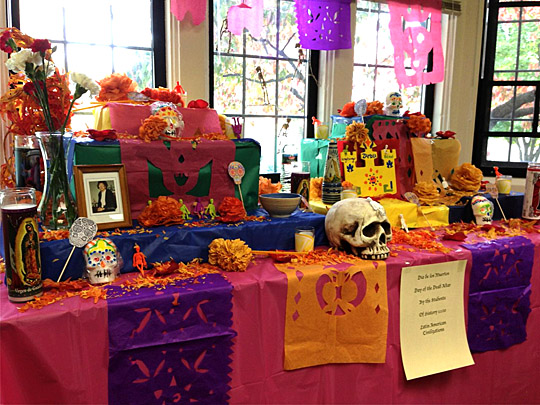The University of Toledo community will celebrate the lives of loved ones who have passed with a Dia de los Muertos altar Monday and Tuesday, Oct. 26 and 27.
Dia de los Muertos, or Day of the Dead, is a Mexican ritual dating back to the 16th century. Day of the Dead is celebrated Nov. 1 and 2, but sometimes can be celebrated for a week before. It coincides with the Day of All Saints and the Day of All Souls, as well as Halloween.

Students in Dr. Charles Beatty-Medina’s Latin American History classes built this ofrenda in the History Department in 2013.
“The dead of one’s family were often viewed as important intermediaries between the realms of life and death,” said Dr. Charles Beatty-Medina, associate professor and chair of the UT History Department. “Burial and mummification were often practiced in ways that allowed for a continuance between the realms of life and death.”
It’s common during Day of the Dead for people to set up ofrendas, or altars, decorated with several different items, he explained. These items may include colorful pieces of paper, photos of loved ones who have passed on, as well as flowers and candy skulls.
An ofrenda will be built in the display cases in the Student Union Trimble Lounge Monday and Tuesday, Oct. 26 and 27. Those who wish to help are invited to participate from 1 to 3 p.m. Oct. 26 and from 2 to 5 p.m. Oct. 27.
The altars will be on display through Friday, Nov. 6.
This will be the first University-wide celebration of Dia de los Muertos, but for the last two years, students in Beatty-Medina’s Latin American History classes have built ofrendas in the History Department.
“At home, participating can be as simple an act as putting together the photos of family members who have passed on and lighting a candle in their honor,” Beatty-Medina said. “Add some flowers and a food or drink that the person loved and you have an ofrenda.”
If participants do bring a family photo, they are asked to bring a photocopy of the original photo. Backing material will be provided to support the photograph.
“It is often a good day for families and friends to get together, eat sugar skulls, have a drink or two, and reminisce and remember their beloved who have passed on,” Beatty-Medina said. “Until one actually does it and sees the photo there, you don’t realize the power, or the popularity, of this day of celebration and honor to the dead.”
Anyone who wishes to participate in the altar building is invited to help. If they wish, they may make a candy skull to display on the altar. The recipe for candy skulls can be found here.
“The reason Day of the Dead has gained such currency is that people outside of Latin America increasingly realize the emotional value of maintaining contact with the memory of their loved ones,” Beatty-Medina said. “Psychologically, it provides a way to deal with the passing from life that everyone must experience.”